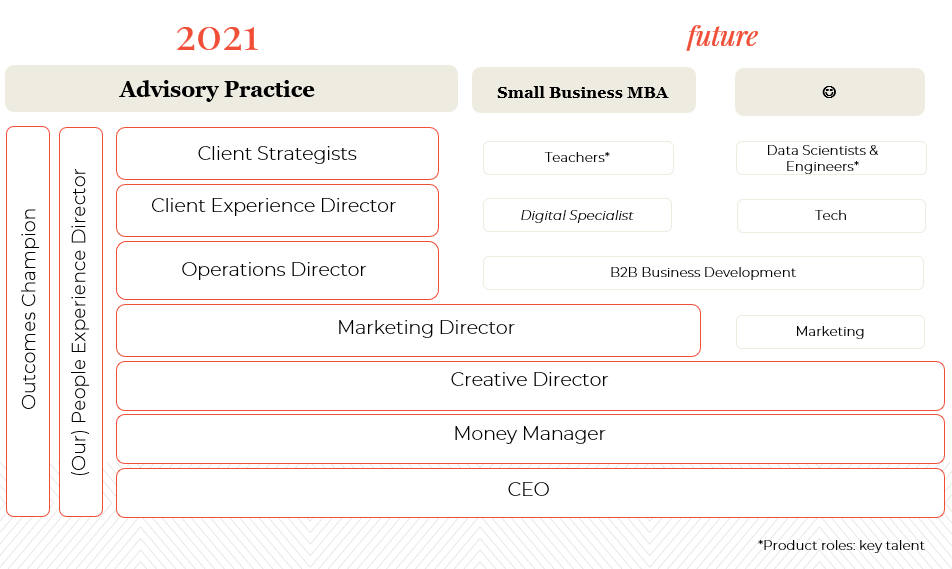How to Make an Org Chart
Good morning!
Last week, I introduced why small businesses should create an org chart – even solopreneurs. So today, I’ll jump right in, to share a quick, simplified guide of how to make an org chart. Plus, a peek of ours at Ellevated Outcomes.
If you did last week’s “homework” to get a head start, you’ve refreshed yourself on your annual plan, which inherently includes some 3- and 1-year goals. So let’s jump right in.

1. Suspend disbelief.
This sounds like a silly first step. But especially for someone as analytical as I am, this is the hardest part (so I feel you, logical thinkers). So to help, we’re going to start with the 3-year org chart.
Why? Three years is far enough in the future to not get hung up on details like, “How am I going to pay for this?” and “How will I find this person?” But it’s not far enough for you to be distracted with, “How in the world would I know what’s going to happen in 10 years’ time? It’s ludicrous to try planning that far ahead!”
Three years is a nice sweet spot to suspend reality a touch but still feel just within reach.
2. Based on your 3-year goals, ask what roles will you need to make this happen?
Please note that I used a subtle but important word above: “roles” not “people.”
Why? Especially if you have a team today, we want to make sure that we’re creating roles (jobs) around the work that your future business needs, not the people working for you today.
I know that it sounds harsh (and scary). But in reality, we find that most small businesses have the wrong people in roles that either aren’t right for them or that the business has outgrown. This is a loaded topic with lots to say, but I’ll leave it here for now: that situation isn’t good for anyone. Making a difficult but correct decision like this (in a kind, human way of course) is good for the business, and good for all the people involved.
Start making a list of these roles. It’s up to you how creative you want to be with titles. The typical things you’d imagine are Marketing, Operations, Finance, Customer Service, CEO (don’t forget about yourself), etc. Because our clients tend to have client intimate business models, they often have experience-based roles like a Business Development & Marketing Director or Client Relations Manager.
3. Draw it out.
We often share this helpful guide and template from E-Myth. But aside from a basic outline, I typically recommend that people don’t Google for examples in their industry.
Why? Employment models are (and should be!) changing. We don’t want clients getting stuck in doing things (a) like their competitors or (b) the way that they’ve always been done. How you structure your people is an opportunity for creativity and competitive advantage.
Think about it this way too: gone are the days of having to hire someone for a full-time, in-person job. If your org chart is truly based on the work your business needs, there will be ample opportunity for virtual assistant(s), contractors, and fractional or outsourced work. For example, clients graciously put Ellevated Outcomes on their org chart as an outsourced strategy department.
This will be a particularly appealing riff for solopreneurs who want to stay solo but break through a plateau. You don’t have to have an extensive payroll and people to manage; you can cleverly piece together a brilliant, outsourced operating model. And this is the first step.
So lastly, I promised that I’d give you a peek at Ellevated Outcomes org chart:

Please note a few things:
1. Ours is further out than 3 years. Shocker: I’m a big picture and long-term, sustainable planner, so I’ve included the additional businesses we’re building. I’ve intentionally left our super long term play blank (I have to keep some things to us 😉), but I am giving you a peek into the Small Business MBA we’re launching in January 2022!!
2. One of my superpowers is scrappiness, ha. So although these are 3 separate businesses, they’re interconnected. Each serves as an R&D laboratory of sorts for the other, so we’ll be able to share resources, including people. Not only is this more efficient financially, but it will make each business better. Plus, it creates growth tracks and cool career opportunities for our people.
3. If you’re familiar with traditional models, this is upside down. I must admit: it wasn’t some kind of mastermind-y, altruistic grand plan (unfortunately, I’m not that great of a human, ha).
I started drawing, and this is just the way it made sense to me. The CEO is the bottom line in terms of accountability and where the buck stops. And I believe that it’s important for someone to take that responsibility. But the people fulfilling the work – Client Strategists in the case of our Advisory Practice, are the talent. They’re making things happen, so it feels to me like they should be at the top.
This too, is the important distinction between being owner-operator and owner. Creating and working toward your future org chart will allow you to intentionally control how you spend your time and what role you play in (or on) your business.


